Speaker
Description
The goal of the CANREB (CANadian Rare isotope facility with Electron Beam ion source) project at TRIUMF is to deliver pure highly charged radioactive ion beams suitable for acceleration and performing experiments to investigate nuclear reactions. Radioactive isotopes at an ISOL facility like ISAC and ARIEL at TRIUMF are produced by bombarding solid targets with high energy particle beams. Singly charged ions can be extracted from an ion source immediately coupled to the target. At present an ECRIS charge state breeding system is used to prepare the ions for further acceleration. CANREB will complement this by providing higher purity of the beams and extending the available mass range. To accomplish this ions are first sent through a high resolution mass separator, where most of the isobaric contaminations can be removed. After this the ions are injected into an RFQ cooler buncher and finally bunches are injected into an EBIS for charge state breeding. In order to meet the acceptance of the following accelerator chain a mass to charge ratio of less than 7 amu/e has to be reached. The bunch repetition time is set to 10 ms. This will allow operation also with short lived isotopes. To guarantee the short breeding time for the entire mass range and to have a high injection efficiency the EBIS is designed to operate at an electron beam density of up to 20 000 A/cm$^2$ with a magnetic field of 6 T. With the EBIS being operated at ultra-high vacuum and no plasma wall interactions additional contaminations induced by the charge state breeding process are expected to be significantly reduced compared with the ECRIS. A drawback is the pulsed operation mode, which can cause pile up in some experiments, and the limitation in total beam intensity given by the buncher, which is at about 10$^7$ ions per bunch.
The system is presently being set-up. First charge state breeding tests with the EBIS have been performed and the results will be reported on.




